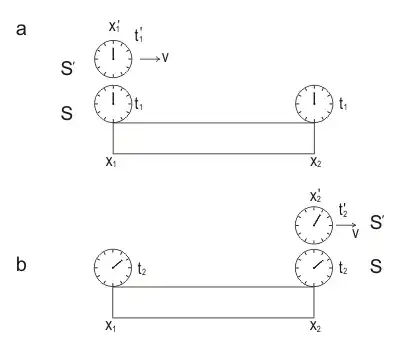Measurement of rate of a moving clock is carried out the following way:
Stationary observer in reference frame $S$ (the observer on earth) places the clock $C_1$ at coordinate $x_1$ of his frame and the clock $C_2$ at coordinate $x_2$ of his frame.
Then this observer sends a beam of light from clock $C_1$ towards clock $C_2$. He assumes, that one - way speed of light is c (Einstein synchrony convention). Since he knows distance and speed of light, he synchronizes these clocks, so as they show “the same time” in reference frame $S$.
https://en.wikipedia.org/wiki/Einstein_synchronisation
Then this observer can measure rate of a clock, which moves in his reference frame $S$
Imagine that moving clock (an observer in the spaceship) $C'$ passes by clock $C_1$ at moment of time $t_1$ first and clock $C_2$ at moment of time $t_2$ some later. At these moments, readings of the moving clock and the corresponding fixed clock of reference frame $S$ next to it are compared.


Let the counters of moving clock measure the time interval $\tau _ {0}$ during the movement from the point $x_ {1}$ to the point $x_ {2}$ and the counters of clocks $C_1$ and $C_2$ of the fixed or “rest” frame $S$, will measure the time interval $\tau$. This way,
$$\tau '=\tau _{0} =t'_{2} -t'_{1},$$
$$\tau =t_{2} -t_{1} \quad (1)$$
But according to the inverse Lorentz transformations we have
$$t_{2} -t_{1} ={(t'_{2} -t'_{1} )+{v\over c^{2} } (x'_{2} -x'_{1} )\over \sqrt{1-v^{2} /c^{2} } } \quad (2)$$
Substituting (1) into (2) and noting that the moving clock is always at the same point in the moving reference frame $S'$, that is,
$$x'_{1} =x'_{2} \quad (3)$$
We obtain
$$\tau ={\tau _{0} \over \sqrt{1-v^{2} /c^{2} } } ,\qquad (t_{0} =\tau ') \quad (4) $$
This formula means that the time interval measured by the fixed clocks is greater than the time interval measured by the single moving clock. Time in reference frame S is running $\gamma$ times faster from the point of view of moving clock $C'$. This means that the moving clock lags behind the fixed ones, that is, it slows down.
The animation below depicts the rest frame (a row of synchronized clocks) and the moving clock (single clock).

Chapter: time dilation
http://www.pstcc.edu/departments/natural_behavioral_sciences/Web%20Physics/Chapter039.htm
NOTE
Proper time is the time on your wristwatch. However, if you are stationary in the reference frame $S$, all clocks in this reference frame, billions of clocks, let’s say, show the same time (according to SR). These clocks do not move relatively to you.
By means of these clocks you can record time and spatial coordinate of an event (when and where it takes place).
Time is the same in the whole reference frame, or your rest frame.
An observer in SR never admits, that he moves. Every observer is at rest in his own reference frame and all other stuff (clocks, rods etc. ) moves around.
Observers in SR change frame. Tom has his own, Ben has his own, Herb has his own etc. It is never mutual.
Thus, an observer in the spaceship does the same trick as the observer on earth. He assumes that he is at rest and the Earth moves. He puts two spatially separated clocks and measures time intervals the same way as the Earthman.
That is drawn on the picture below.
I don’t know what to say if these proper times are the same. May be they are rather personal.
Good to note - as soon as an observer assumes, that he is not at rest but he is in moton an certain reference frame, he will see, that all clocks are ticking faster, than his own and measuring rods are longer than his own.


